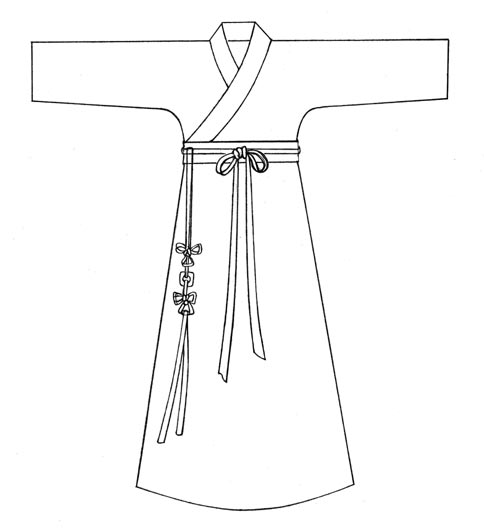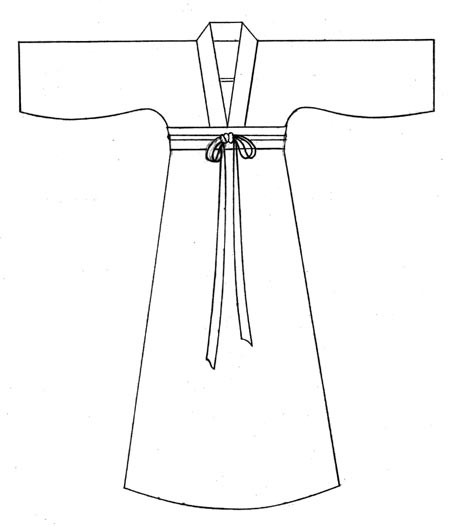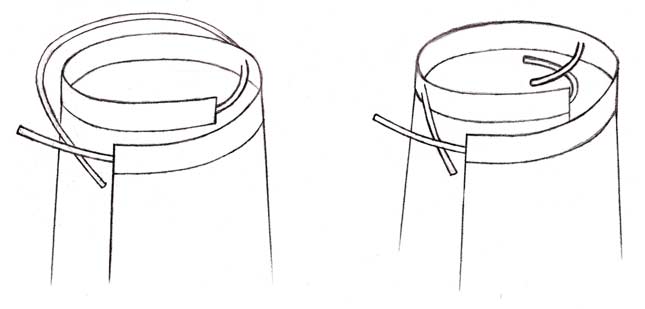Han Couture: Dress Jacket
Cheng Minghua
As one of the ancient civilizations of the world, China is also well known for its apparel. In its five-thousand-year history, China had established a splendid culture and made tremendous contributions to the advancement of human civilization.
There were many dynasties in Chinese history; each dynasty had many styles of attire. Here we introduce the most popular style for women throughout the dynasties—the dress jacket.
The dress jacket appeared as early as during the Spring-Autumn Warring States Period (770-221 BC). It was described as “long skirt with waist ties and big sleeves connected to shirt jacket” in ancient poems. Since then, dynasty after dynasty, for two thousand years through the end of Ming Dynasty, although the length and width of the sleeves might vary, the basic style remained the same.
“Dress jacket” is composed of an upper short shirt jacket, also called waist jacket with a length over the waist, and the lower floor-length skirt. One tucks the jacket inside the skirt. Out side the skirt, a long silk belt is tied around the waist, often accompanied by a piece of jade or ring to keep the belt close to the skirt and to prevent the skirt from being blown upward. A cotton shawl, also called art cotton, was also wrapped around the arms. In addition, the lady would wear matching decorative head dresses in the hair to appear delicate and elegant.
The collar of the upper shirt jacket can be straight or cross; when it is cross, the left side of the jacket is pulled to the right as in Figure 1.
With the straight collar, appearing during Tang and Sui Dynasties, the shirt jacket has a side by side look as in Figure 2. The neckline opens slightly with no securing string to reveal a little bit of the under shirt. There are also a variety of sleeves: wide, narrow and waisted, for instance. Its construction can be single-, double-layered, or cotton-stuffed. In winter, the outfit may be lined with silk cotton to keep one warm and comfortable at the same time. Relics from an excavated tomb in Gansu Province contained such an example.
During the early stage of Han couture development, the women’s apparel was similar to the men’s one-piece robe, but later the dress jacket became the main style. The skirt in Han couture evolved from “shang”. The difference between skirt and shang is that shang is comprised of two pieces, the front consists of three pieces of fabric, and the back of four pieces. When covering the lower body, it leaves an opening on both sides. The skirt on the contrary is made of one piece of fabric and wraps around the body, from the front to the back, with one opening only. The skirt is normally spliced together with 5, 6, or 8 pieces of fabric and in a fan-shape. In some dynasties, 10-12 pieces of fabric were also used. (Figure 3-4)
In paintings of Chinese ladies across the dynasties, the subjects are usually adorned with dress jackets. In popular themes such as “Goddess Lu’’, “Celestial Maiden Ma-Gu Presenting a Birthday Gift” and “Celestial Maidens Spreading Flowers”, people have come to associate this attire with the image of their favorite goddesses. No wonder the dress jacket is so popular -- because it comes from the heavens.
Illustrations of shirt jacket and skirt:
 |
 |
| Figure 1: Cross collar | Figure 2: Straight collar |
 |
| Figure 3: Tie the left-side string first and then the right side string |
 |
| Figure 4: Introducing two ways to wear the skirt, wrap-around skirt. The width of skirt needs to be at least 1.5 times of the waist line |
(1) There is a hole in the waist band. The cords from the waist band goes through the hole. The cord on the side must be long enough to go around the waist twice, otherwise part of the waist will not show the cord.
(2) After the cords are fastened from both sides, a belt is placed out side of waist band -- provides security and decoration. The belt should be at least long enough to reach the knees.




 globalcompetitions.org
globalcompetitions.org